PHOTOS: Southern California wildfires
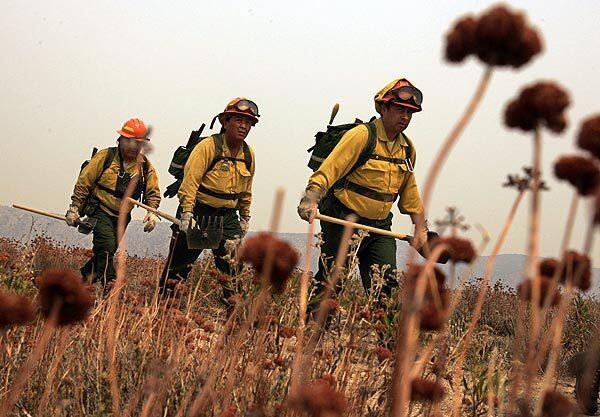
Fire crews from New Mexico cut a fire line in Juniper Hills to keep the Station fire from spreading. Overnight Saturday, the blaze grew to 157,220 acres, making it the 10th-largest fire in modern California history, fire officials said. The fire was 51% contained. A large plume of smoke drifted into the areas of Juniper Hills and Littlerock, and Incident Commander Michael Bryant said the fire was about five miles from Juniper Hills. We want our communities not to panic, Bryant said. Fire officials said the fires jump of the Angeles Crest Highway also threatened several structures. (Irfan Khan / Los Angeles Times)
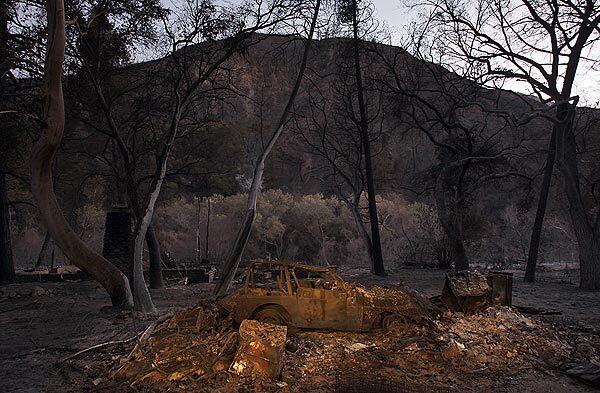
An incinerated car sits in the devastated hamlet of Vogel Flats, which is along Big Tujunga Canyon Road in the Angeles National Forest. (Luis Sinco / Los Angeles Times)
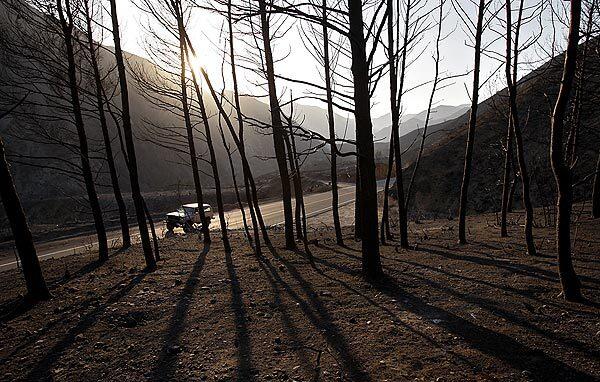
A landscape charred by the Station fire lines both sides of Big Tujunga Canyon Road in the Angeles National Forest. (Luis Sinco / Los Angeles Times)
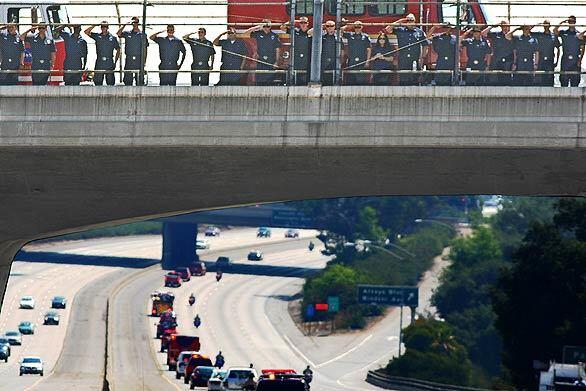
Firefighters, top, stand at attention and salute the procession along the 210 Freeway escorting the casket of Los Angeles County Fire Capt. Ted Hall, who was killed in the Station fire. ((Don Bartletti / Los Angeles Times))
Advertisement
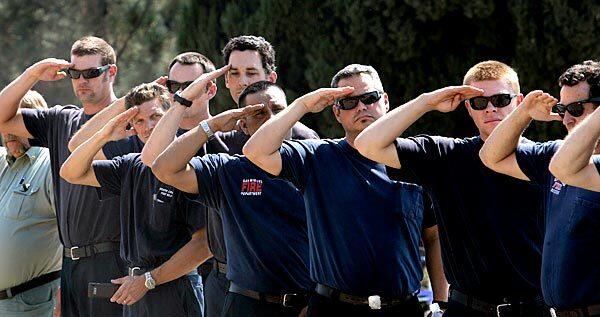
Firefighters salute a hearse carrying L.A. County Fire Capt. Ted Hall as a motorcade passes the fire command center at Hansen Dam. Hall, 47, and firefighter specialist Arnaldo Quinones, 34, was killed Sunday when their firetruck tumbled 800 feet down a steep slope near Mt. Gleason, just south of Acton. (Spencer Weiner / Los Angeles Times)
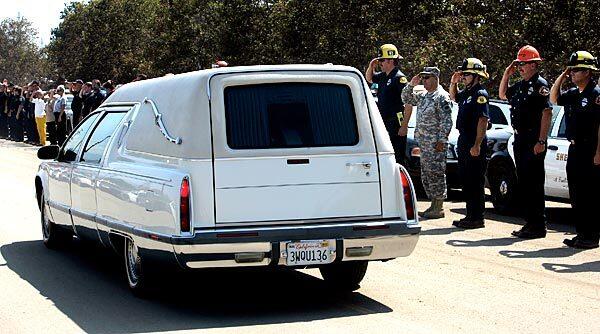
The procession included a white hearse, police motorcycles and an L.A. County fire engine with the words “All Day. All Night” above the front windshield. (Spencer Weiner / Los Angeles Times)
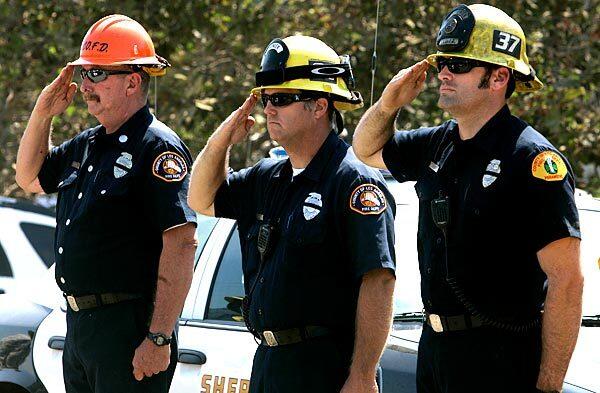
The procession for Capt. Hall was on its way from North Hollywood to a mortuary in Victorville. Quinones’ body was transferred Thursday to a mortuary in Lancaster. (Spencer Weiner / Los Angeles Times)
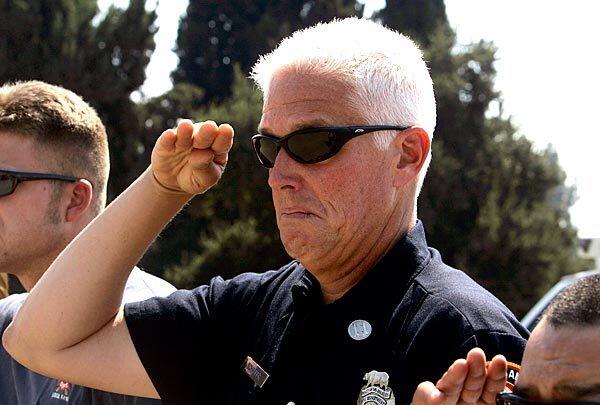
In addition to the procession, a formal memorial is planned for 10 a.m. Sept. 12 at Dodger Stadium. (Spencer Weiner / Los Angeles Times)
Advertisement
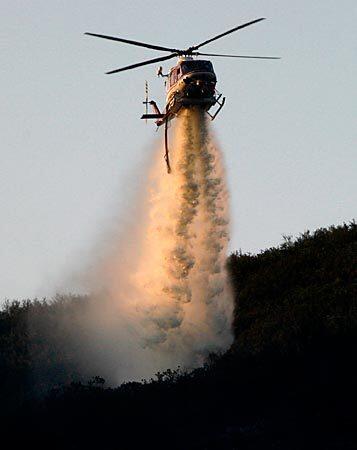
At daybreak, an Orange County Fire Authority helicopter drops water on a blaze off Ortega Highway in the Cleveland National Forest about 12 miles east of San Juan Capistrano. The fire was reported shortly after midnight and burned about 25 acres before it was fully contained. (Mark Boster / Los Angeles Times)
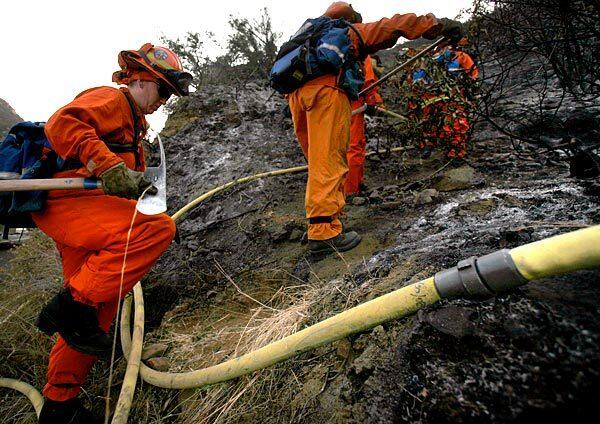
An inmate fire crew hikes up a hillside off Ortega Highway. (Mark Boster / Los Angeles Times)
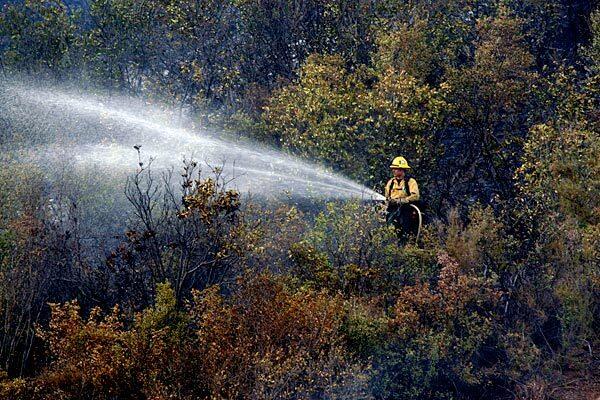
A U.S. Forest Service firefighter attacks a hot spot in the Cleveland National Forest. (Mark Boster / Los Angeles Times)
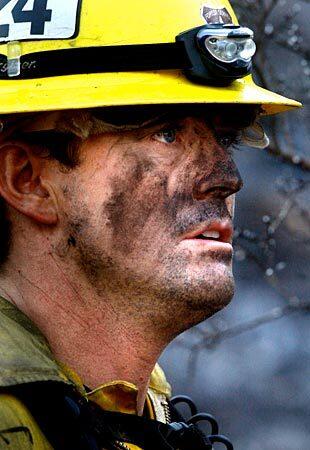
U.S. Forest Service firefighter Dave Morgan looks at a hillside in the Cleveland National Forest where he and other firefighters made quick work of a 25-acre blaze. (Mark Boster / Los Angeles Times)
Advertisement
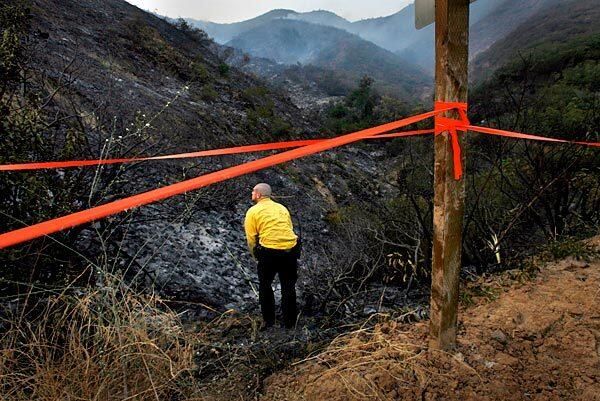
An arson investigator searches for clues near the source of the 25-acre fire off Ortega Highway. (Mark Boster / Los Angeles Times)
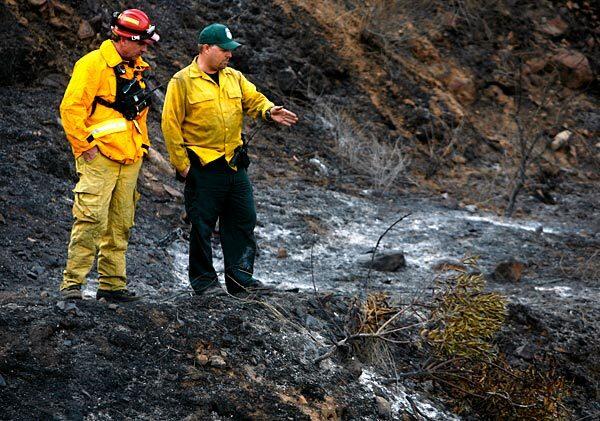
Fire investigators look for evidence near the source of the fire off Ortega Highway. (Mark Boster / Los Angeles Times)
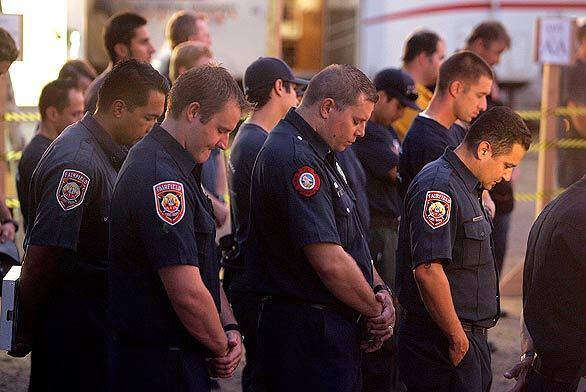
Firefighters preparing to resume the battle against the Station fire bow their heads early Friday in remembrance of two of their own killed while fighting the blaze: Los Angeles County Fire Capt. Tedmund “Ted” Hall, 47, and Firefighter Spc. Arnaldo “Arnie” Quinones, 34, who died Sunday when their truck plunged down a hillside. A formal memorial is planned for 10 a.m. Saturday at Dodger Stadium. (Spencer Weiner / Los Angeles Times)
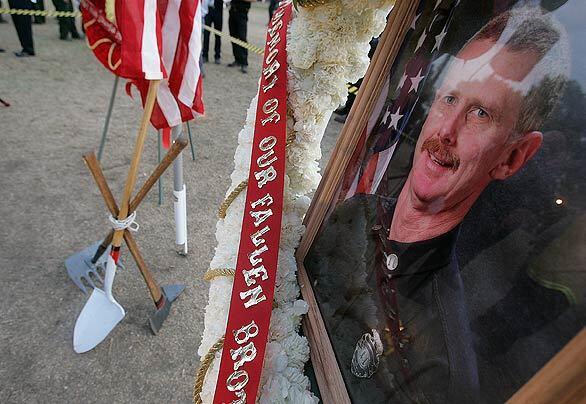
Firefighters set up a memorial for fallen colleagues Los Angeles County Fire Capt. Ted Hall, right, and Firefighter Spc. Arnaldo Quinones at the command center at Hansen Dam Park on Friday. (Spencer Weiner / Los Angeles Times)
Advertisement
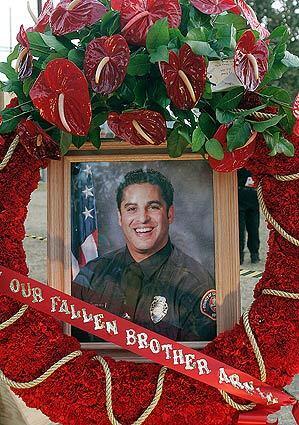
A wreath honoring
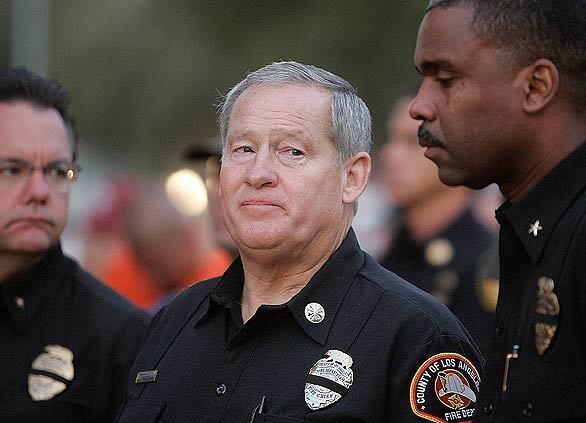
Los Angeles County Fire Chief Michael Freeman, center, joins firefighters to honor Hall and Quinones. (Spencer Weiner / Los Angeles Times)
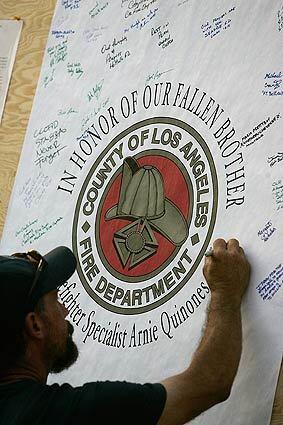
Firefighters sign a poster to honor Hall and Quinones. (Spencer Weiner / Los Angeles Times)
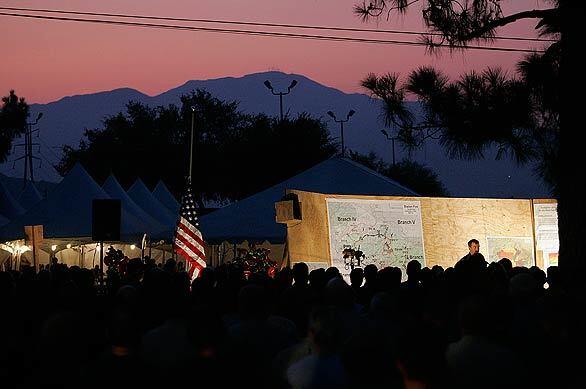
Firefighters attend a small memorial for Hall and Quinones. (Spencer Weiner / Los Angeles Times)
Advertisement
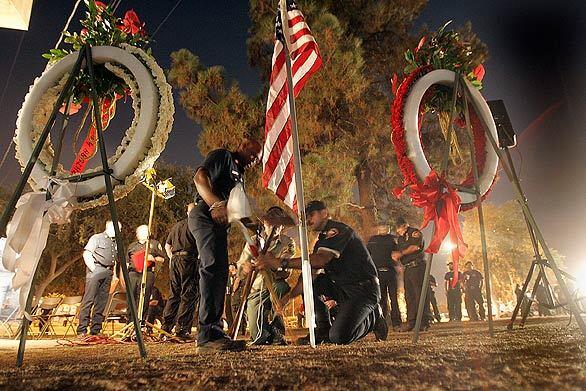
Before dawn Friday, firefighters build a small memorial to honor Hall and Quinones. A formal memorial is planned for 10 a.m. Saturday at Dodger Stadium. (Spencer Weiner / Los Angeles Times)
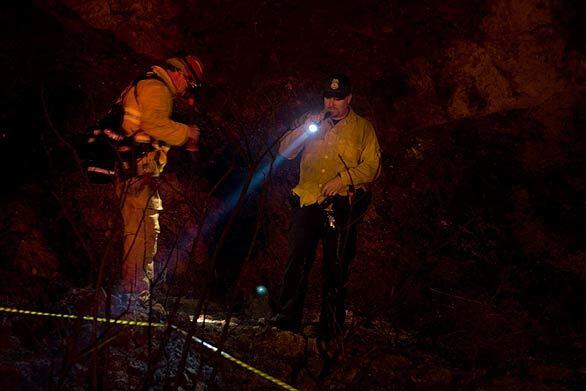
Investigators Mike Smathers, right, of the U.S. Forest Service and Steve Pardi of the Orange County Fire Authority examine the possible ignition site of a new fire, of suspicious origin, that broke out overnight along the Ortega Highway in Cleveland National Forest east of San Juan Capistrano and had burned about 25 acres by morning. (Don Kelsen / Los Angeles Times)
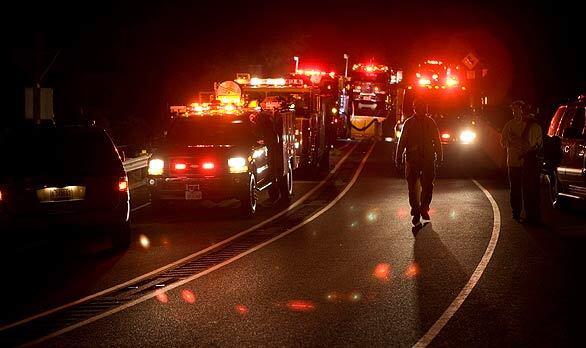
Emergency vehicles crowd the Ortega Highway in Cleveland National Forest east of San Juan Capistrano, where a new brush fire broke out overnight. (Don Kelsen / Los Angeles Times)
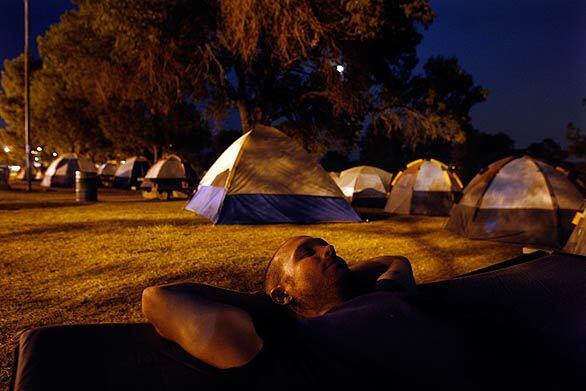
At the Station fire command post at Hansen Dam Park, Johan Nilsson, 29, of the Carpenteria Summerland Fire Protection District, sacks out on a cot at the end of his eighth day of fighting the blaze. (Genaro Molina / Los Angeles Times)
Advertisement
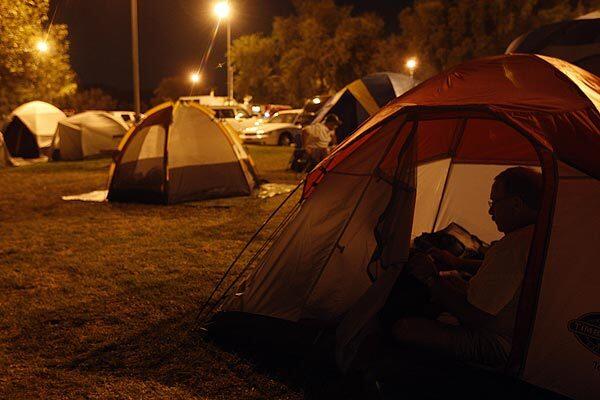
Bill Hunter of the Alabama Incident Management Team prepares to get some sleep in the tents provided for firefighters at the fire command post at Hansen Dam Park. (Genaro Molina / Los Angeles Times)
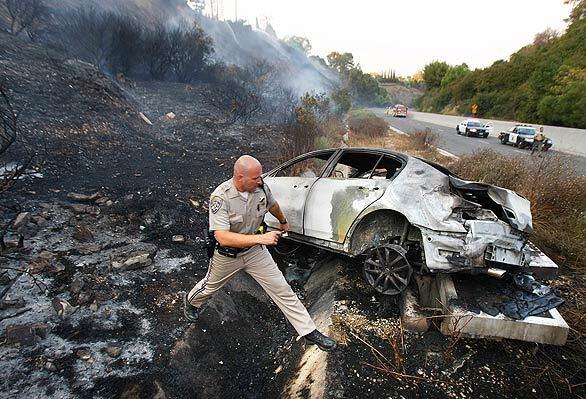
California Highway Patrol Officer M. Mezger walks around a car that crashed on Crenshaw Boulevard on Thursday, starting a fire that burned 3 acres in Rolling Hills Estates. Two occupants of the car were taken to a hospital. (Wally Skalij / Los Angeles Times)
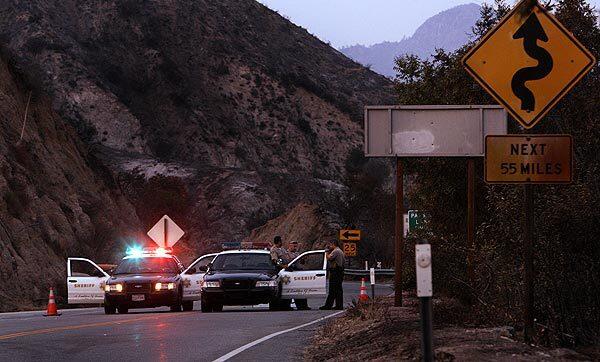
Sheriff’s deputies continue to block access to Angeles Crest Highway as an arson team investigates the point of origin of the Station fire about three miles north of Foothill Boulevard. (Gina Ferazzi / Los Angeles Times)
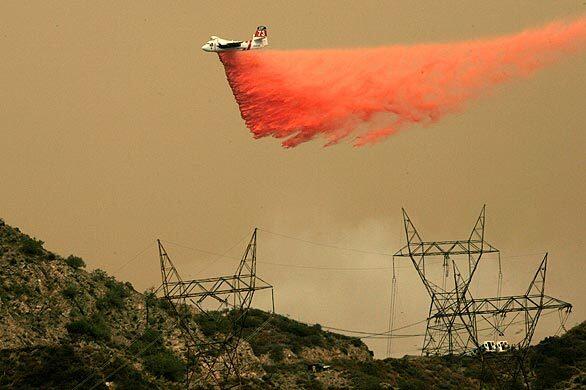
A plane makes a fire retardant drop on the Station fire on ridges along Little Tujunga Road. (Irfan Khan / Los Angeles Times)
Advertisement
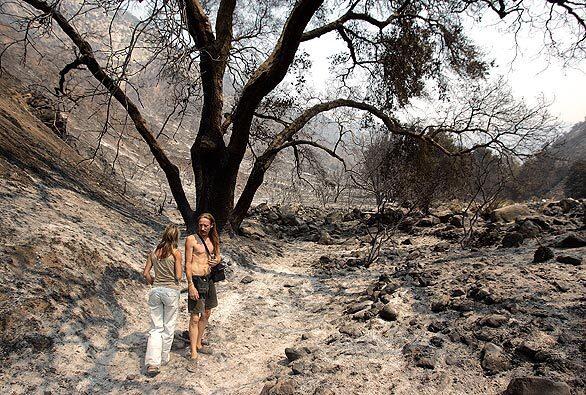
Suzette Brantley and Nicholas Vowrin visit the remnants of one of their favorite forest trails near Gold Creek Ranch in the Angeles National Forest. (Spencer Weiner / Los Angeles Times)
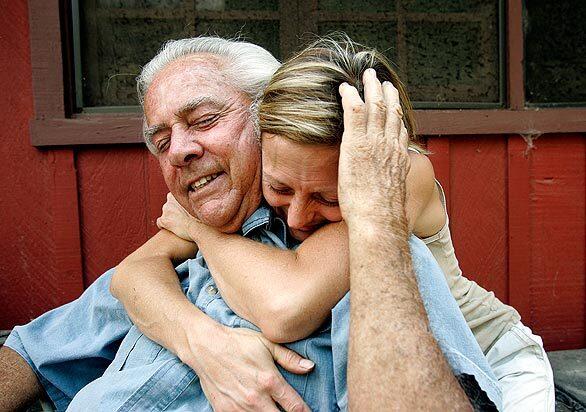
Jack Johnson, a 30-year resident of Gold Creek Ranch, gets a hug from friend Suzette Brantley. (Spencer Weiner / Los Angeles Times)
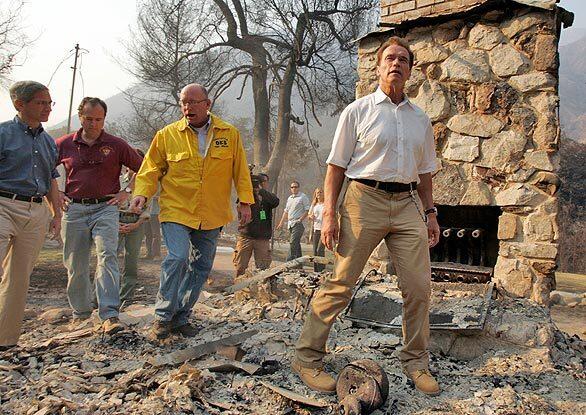
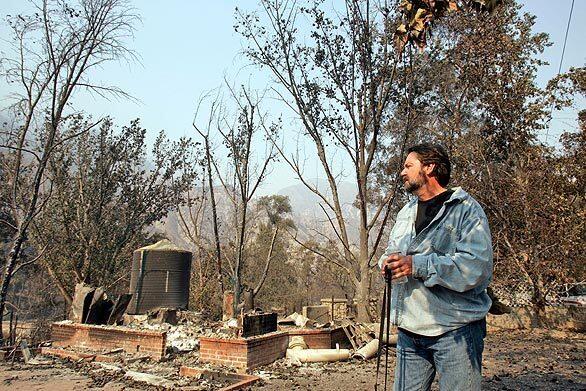
Bert Voorhees lost his home to the Station fire in the community of Vogel Flats. (Irfan Khan / Los Angeles Times)
Advertisement
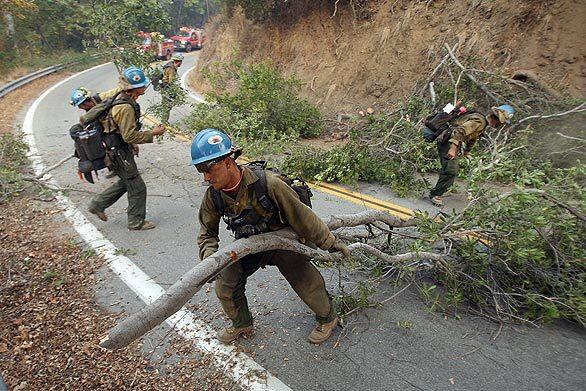
Firefighters of the Blue Ridge Hot Shots crew from the Coconino National Forest in
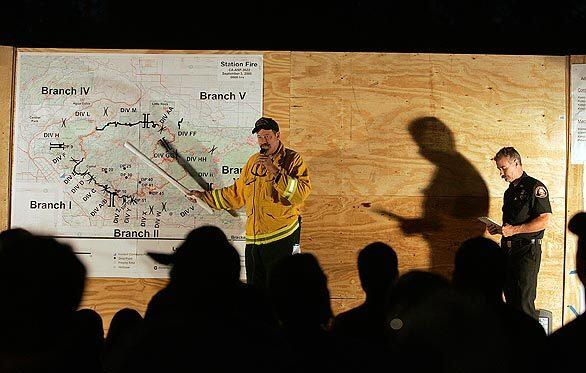
Operations Section Chiefs Don Will, left, and Roy Dull give firefighters the latest information before they head out to the fire during a 6 a.m. briefing at the Station fire inter-agency command center at Hansen Dam Park Thursday. (Spencer Weiner / Los Angeles Times)
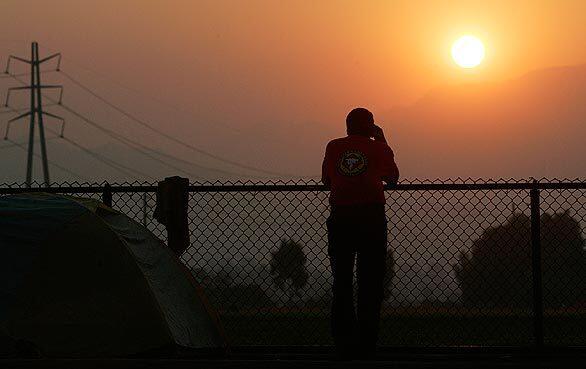
Sunrise at the Station fire command center at Hansen Dam Park. The western leg of the fire pushed toward Pacoima Canyon, prompting the evacuation of 11 homes. (Spencer Weiner / Los Angeles Times)
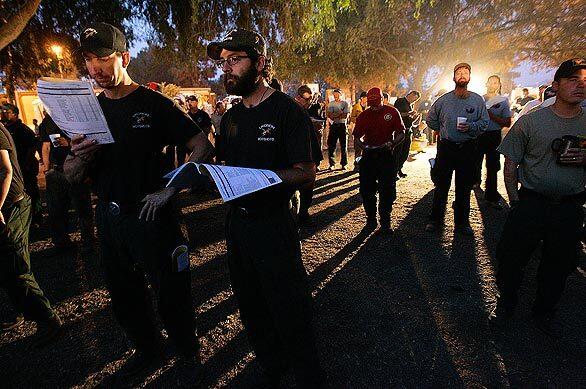
Firefighters gather for the 6 a.m. briefing at the Station fire command center at Hansen Dam Park. (Spencer Weiner / Los Angeles Times)
Advertisement
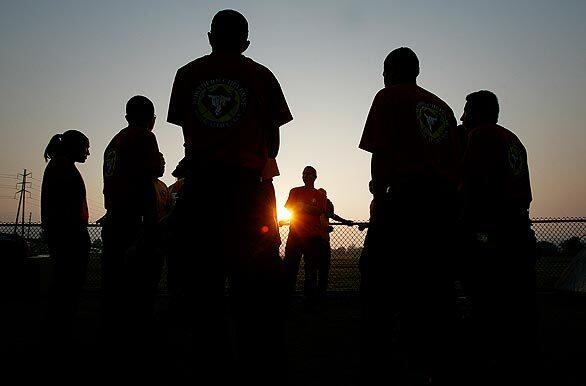
Firefighters from the Northern Cheyenne Initial Attack Crew in Montana hold a morning meeting at Hansen Dam Park. (Spencer Weiner / Los Angeles Times)
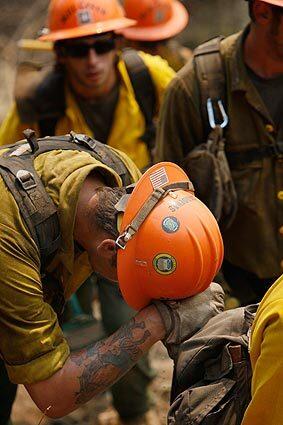
Mill Creek Hot Shot crew members stop for a breather as they cut a fire line behind homes near Oak Crest Road in Sierra Madre. (Robert Gauthier / Los Angeles Times)
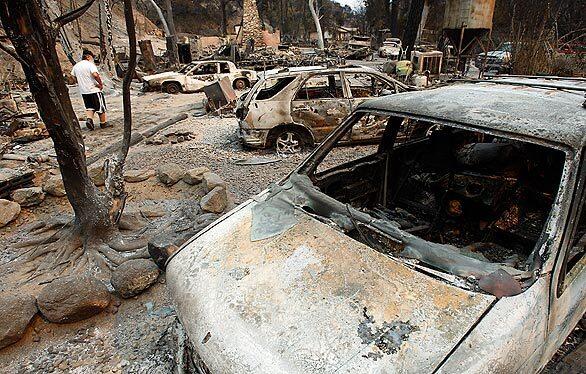
Tony Cambria, 70, surveys one of about a dozen homes on Stonyvale Drive in Tujunga burned to the ground by the Station fire. Some residents returned Wednesday to homes they had evacuated in the face of 50-foot-high flames. (Luis Sinco / Los Angeles Times)
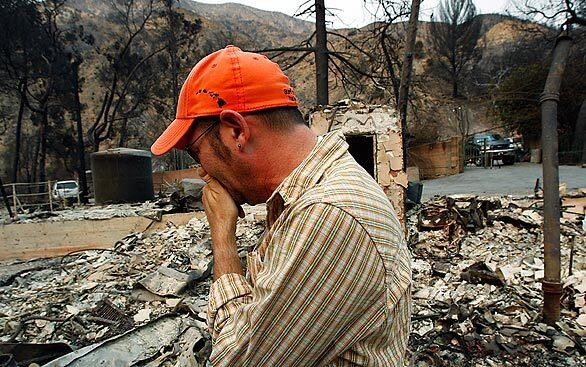
A man who identified himself only as Adi is overcome with emotion as he surveys the charred ruins of his home Wednesday in the 2400 block of Stonyvale Road in Tujunga. (Luis Sinco / Los Angeles Times)
Advertisement
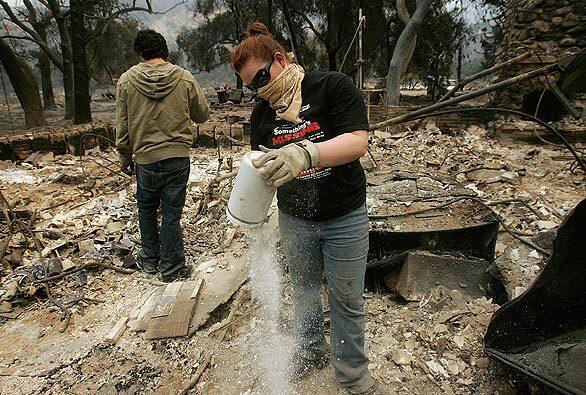
Tiffany Brain searches for anything of value of what’s left after the Station fire destroyed her uncle’s home in Big Tujunga Canyon. (Spencer Weiner / Los Angeles Times)
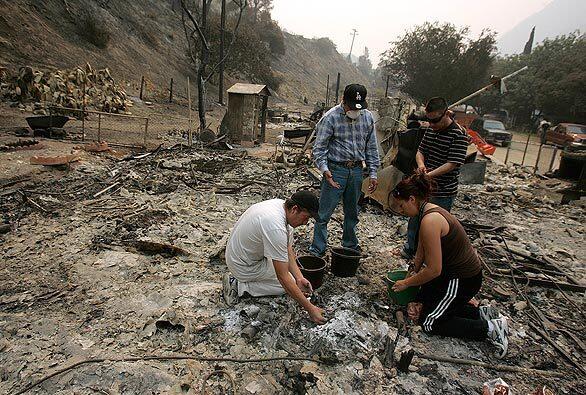
Jose Palio, left, searches with friends through the rubble of his home after the Station fire raged through Big Tujunga Canyon. Palio, who has lived in the Stonyvale neighborhood for eight years with his four children, returned for the first time Wednesday to survey the damage. (Spencer Weiner / Los Angeles Times)
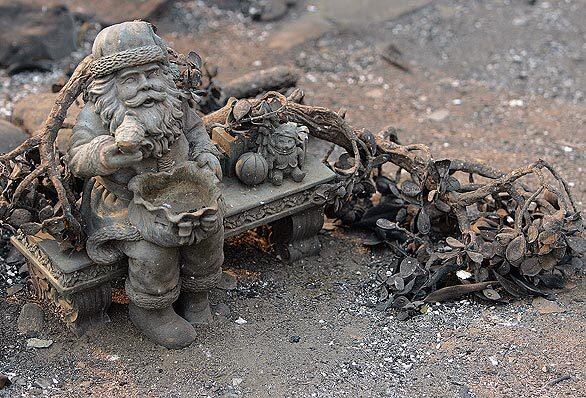
A Santa garden sculpture sits in a charred garden after the Station fire raged through Big Tujunga Canyon. Dozens of homes in the Stonyvale neighborhood were destroyed or damaged. (Spencer Weiner / Los Angeles Times)
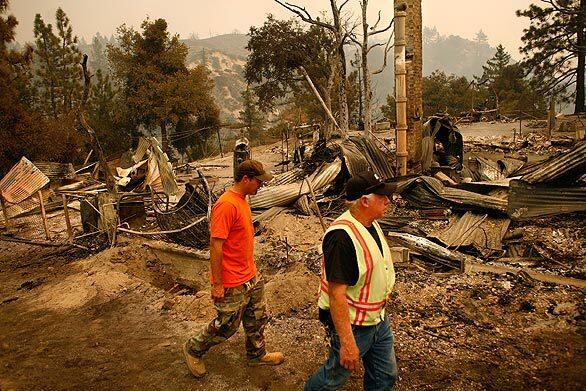
Caltrans employees who lived on the property of the Chilao Caltrans depot on Angeles Crest Highway walk past what remains of one of the three homes destroyed by the Station fire. (Jay L. Clendenin / Los Angeles Times)
Advertisement
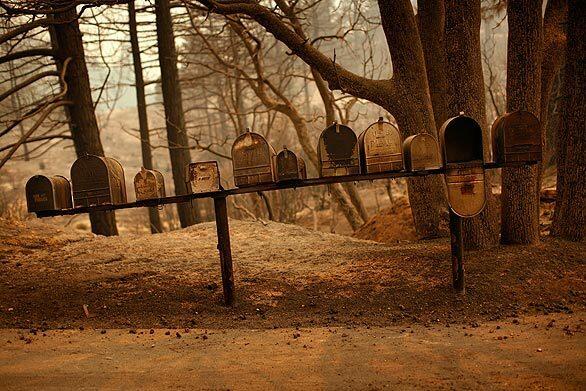
Scorched mailboxes are seen outside the Chilao Caltrans depot. (Jay L. Clendenin / Los Angeles Times)
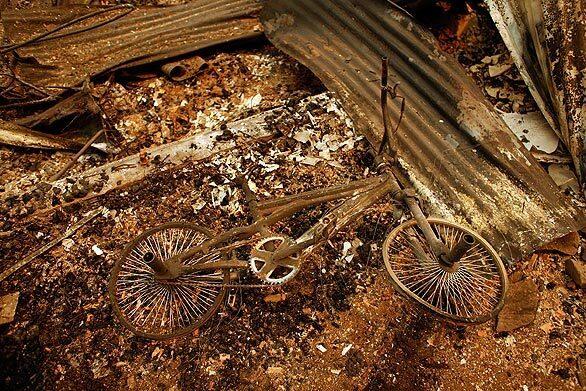
A charred bicycle rests in the burned debris of a home at the Chilao Caltrans depot. (Jay L. Clendenin / Los Angeles Times)
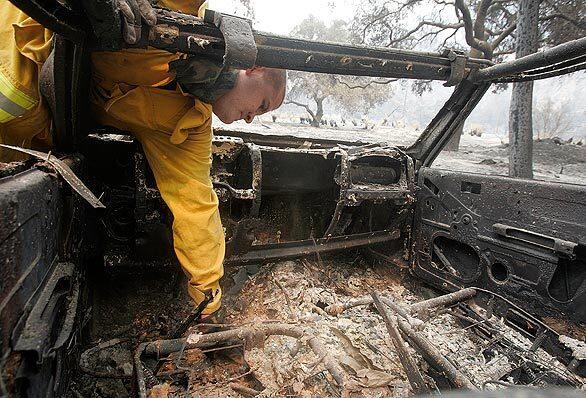
Travis Riner searches for anything of value after the Station fire burned his uncle’s property in Big Tujunga Canyon. Riner and his girlfriend had been staying at the house. (Spencer Weiner / Los Angeles Times)
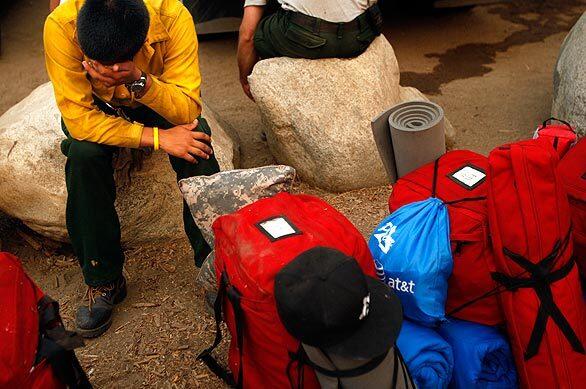
Arley Baca of the Southern Pueblos Agency of
Advertisement
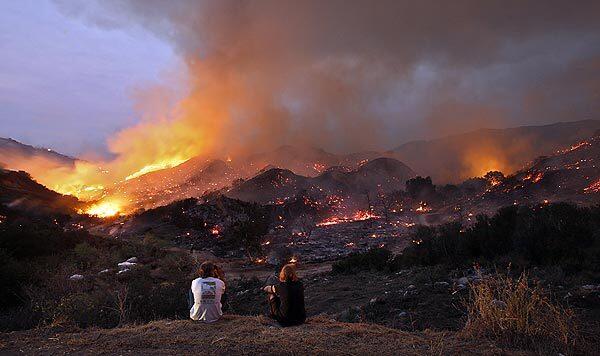
Sunland residents Michael and Susan Schaafsma watch the hills near their home burn at twilight on Tuesday. (Luis Sinco / Los Angeles Times)
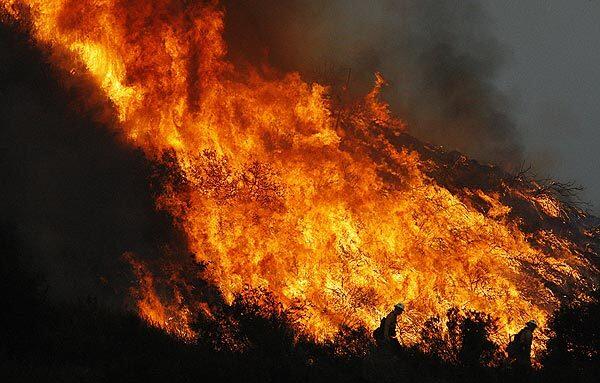
Firefighters are silhouetted against a blazing hillside in Sunland on Tuesday. Cooler, cloudier and more humid weather has slowed the progress of the Station fire, which continues to burn in the mountains north of Los Angeles. (Luis Sinco / Los Angeles Times)
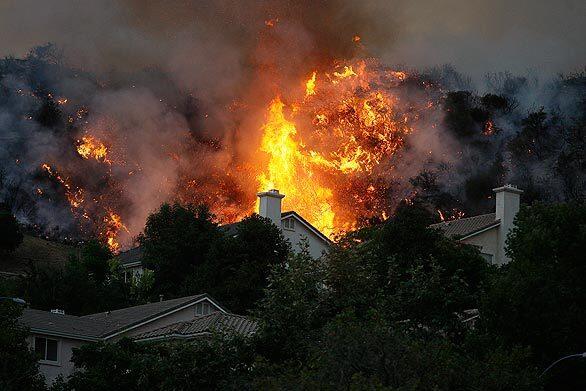
A back fire burns along a ridge above homes on Sky Ridge Drive in La Crescenta. (Robert Gauthier / Los Angeles Times)
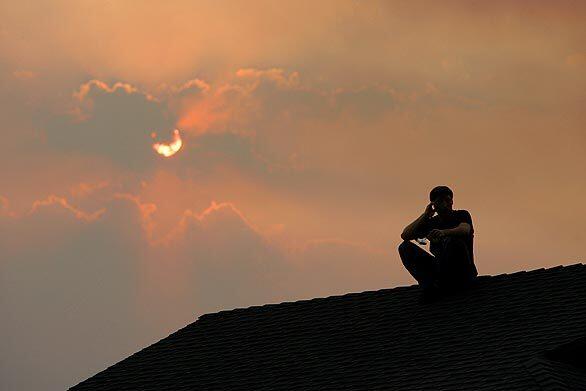
A resident sits on his roof to watch the Station fire burn in a canyon near homes off Boston Avenue in La Crescenta. (Gina Ferazzi / Los Angeles Times)
Advertisement
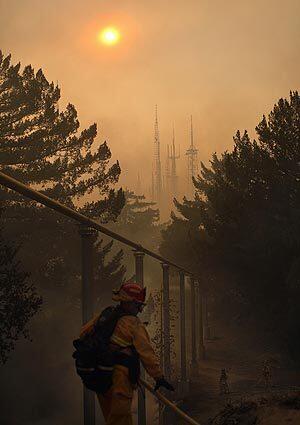
Members of the Mule Creek State Prison Fire Department work on a back burn beneath equipment supporting the Mt. Wilson Observatory telescopes as the Station fire moves closer Tuesday. In the background are radio and TV antennae. (Jay L. Clendenin / Los Angeles Times)
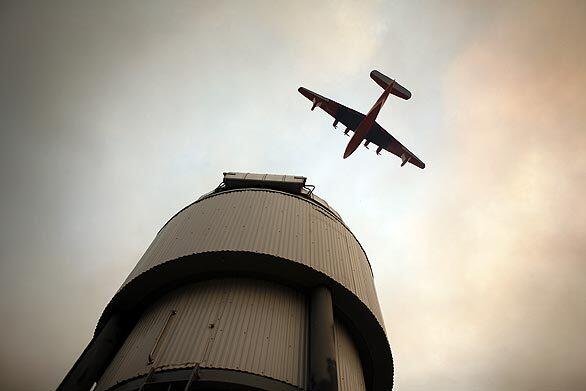
A Martin Mars Super Scooper flies over one of the telescopes atop Mt. Wilson, moments before dropping 7,200 gallons of water to keep flames away from the Mt. Wilson Observatory and radio towers Tuesday. (Jay L. Clendenin / Los Angeles Times)
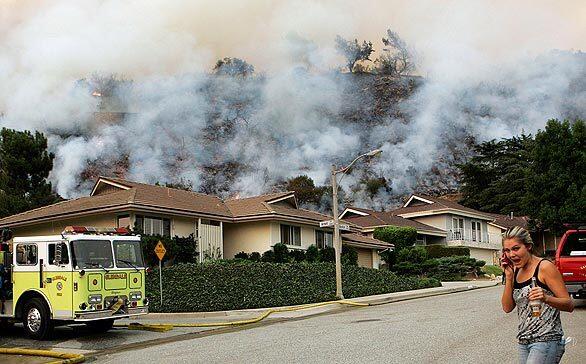
A resident talks on her cellphone as a smoky hillside looms behind homes on Boston Avenue in La Crescenta on Tuesday. (Gina Ferazzi / Los Angeles Times)
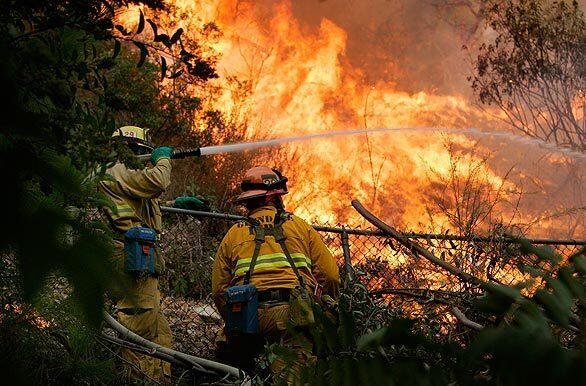
Firefighters douse brush as flames burn in a canyon, moving away from a home on Arnell Place in La Crescenta on Tuesday. (Gina Ferazzi / Los Angeles Times)
Advertisement
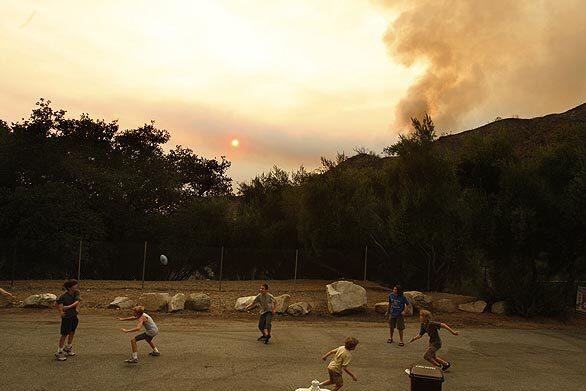
Kids play football after being allowed to return to their homes on Goss Canyon Avenue with the Station fire still burning beyond the charred hills in La Crescenta on Tuesday. “Yesterday it was a battle zone. Now it’s a football field again,” said resident John Kornarens, who has lived on the street for two years. (Genaro Molina / Los Angeles Times)
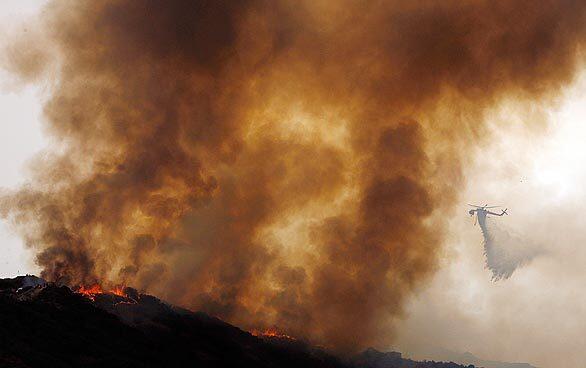
A helicopter drops water on a burning ridgeline in Tujunga. Cooler, cloudier and more humid weather has slowed the progress of the Station fire, which continues to burn out of control in the mountains north of
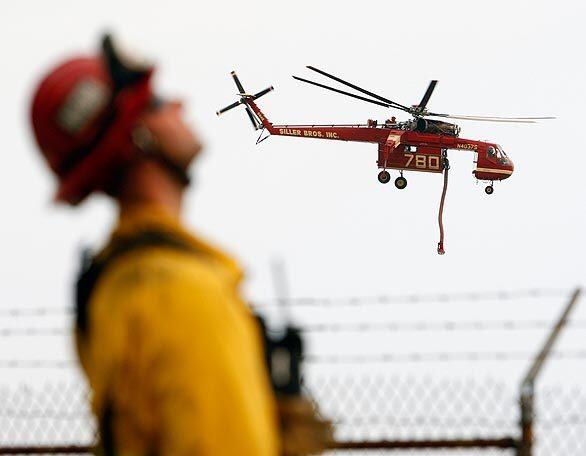
A water-dropping helicopter hovers near the southwestern flank of the Station fire, where California Office of Emergency Services firefighters monitor the progress. (Robert Gauthier / Los Angeles Times)
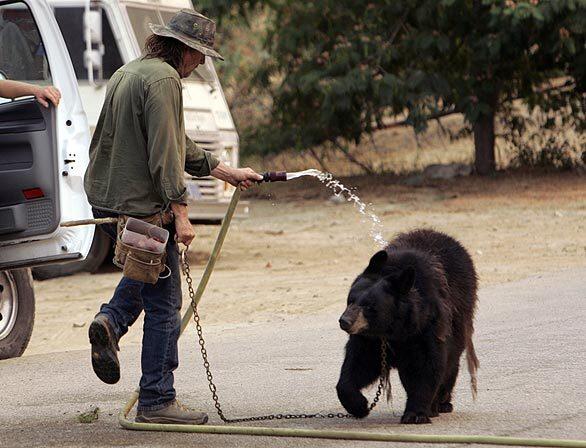
Neil Egland cools off Kachina, an American black bear, who is being evacuated from the Wildlife Waystation. (Al Seib / Los Angeles Times)
Advertisement
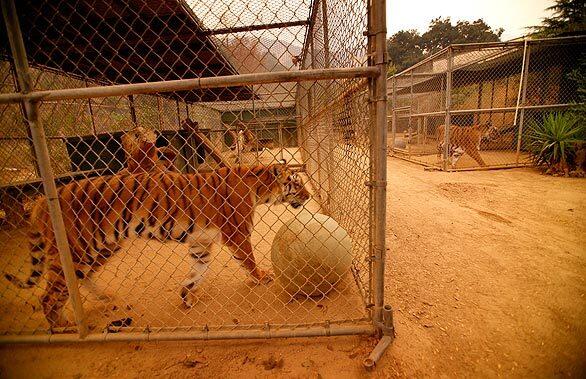
Tigers pace in their cage at the Wildlife Waystation. Volunteers are working to evacuate as many of the animals from the Angeles National Forest facility as possible. (Al Seib / Los Angeles Times)
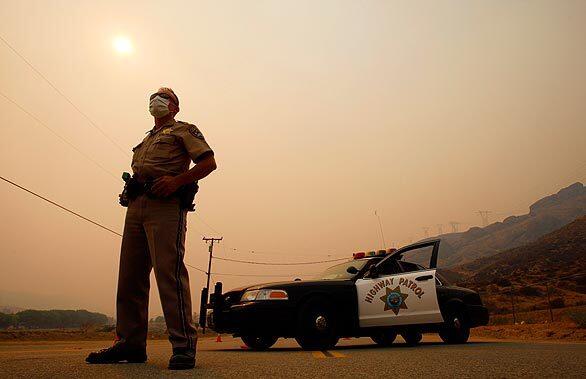
California Highway Patrol Officer
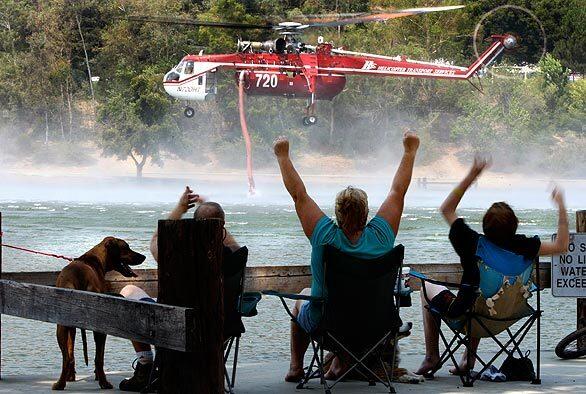
From a lakeside dock in Yucaipa Regional Park, the McHenry family cheers as a Sikorsky S64 Sky Crane firefighting helicopter goes “In the Dip” for another load of water Tuesday. The parents and their son spent the night camping in the park after receiving a mandatory evacuation order from their nearby home. By about midday, half dozen aircraft were dousing hot spots in the all but extinguished Pendleton and Oak Glen fires. Cal Fire officials kept all firefighters and gear in the park in case lighting strikes or wind start new fires overnight. (Don Bartletti / Los Angeles Times)
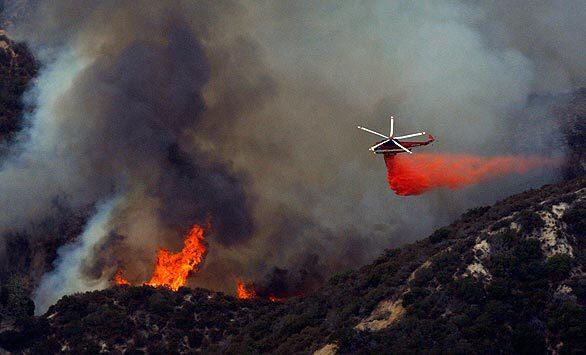
A helicopter drops fire retardant on a part of the Station fire burning close to homes in Tujunga’s Blanchard Canyon. (Genaro Molina / Los Angeles Times)
Advertisement
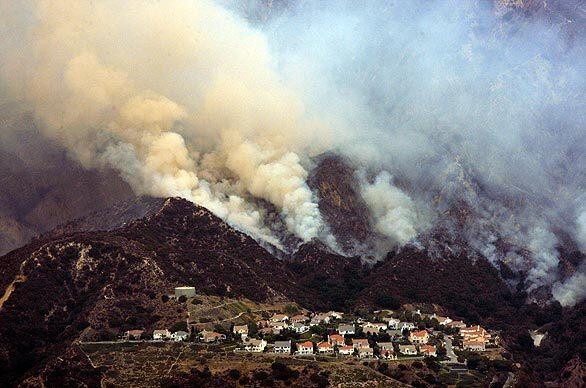
The Station fire burns above homes in La Crescenta. (Genaro Molina / Los Angeles Times)
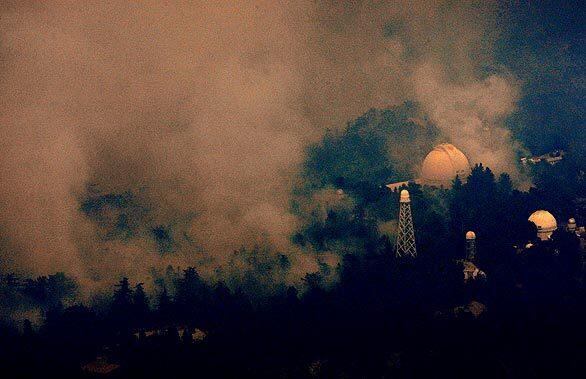
Flames from the Station fire approach Mt. Wilson Observatory in the Angeles National Forest. (Genaro Molina / Los Angeles Times)
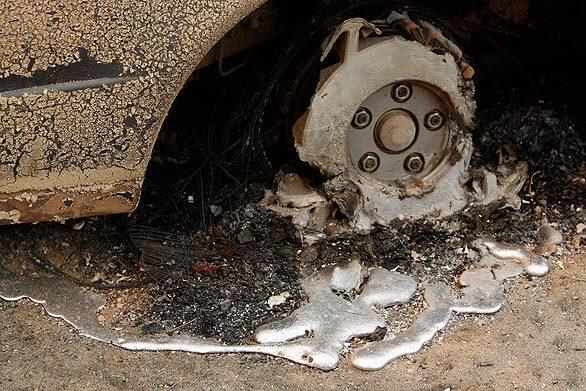
A car tire is completely melted by fire in Acton’s Aliso Canyon. (Francine Orr / Los Angeles Times)
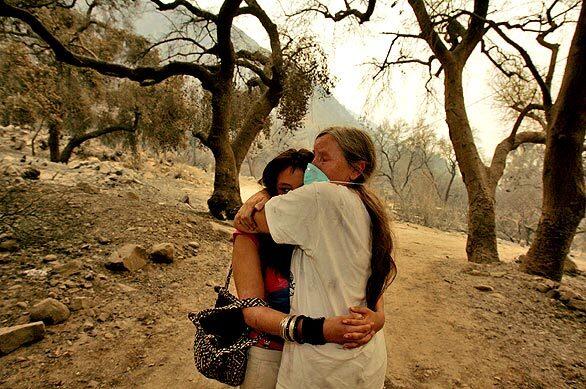
Julie Garcia, 59, and her daughter Jessi Garcia, 19, hug each other Tuesday after seeing their home gutted by the Station fire that swept through their neighborhood on La Paloma Canyon Road at Vogel Flat in Tujunga. (Irfan Khan / Los Angeles Times)
Advertisement
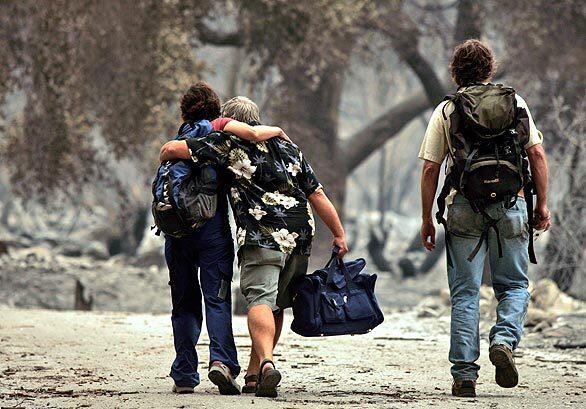
Tujunga neighbors support each other as they walk on La Paloma Canyon Road towards their homes in Vogel Flat. (Irfan Khan / Los Angeles Times)
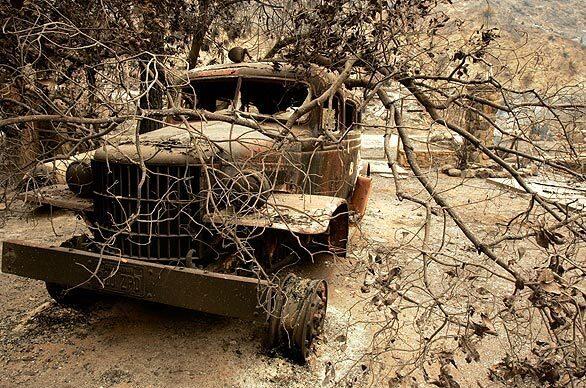
Charred remains of a vintage vehicle that was destroyed when the Station fire swept through the Delta Flat area of Tujunga. (Irfan Khan / Los Angeles Times)
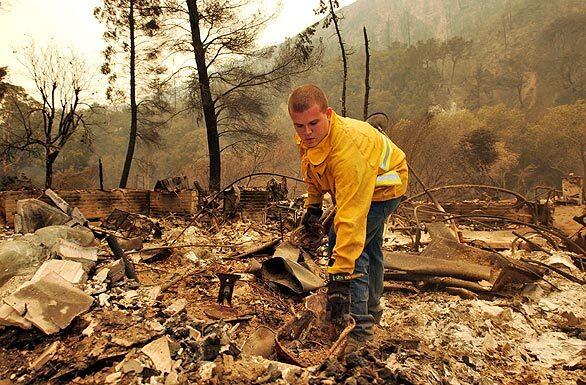
Travis Riner, 25, tries to salvage whatever he can from the charred remains of the home where he had lived for eight years on the 3000 block of Stonyvale Road at Vogel Flat in Tujunga. (Irfan Khan / Los Angeles Times)
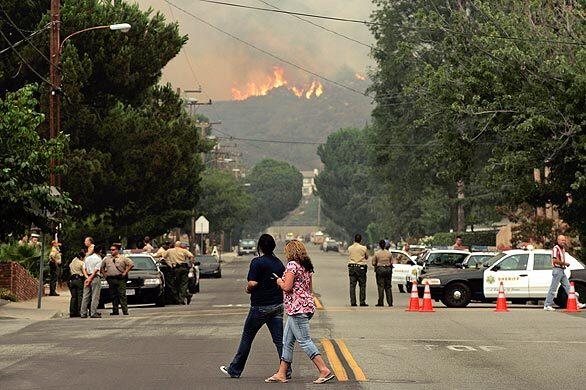
A view of Pennsylvania Avenue in La Crescenta where people gathered to watch the fire raging in the mountains on Tuesday morning. (Irfan Khan / Los Angeles Times)
Advertisement
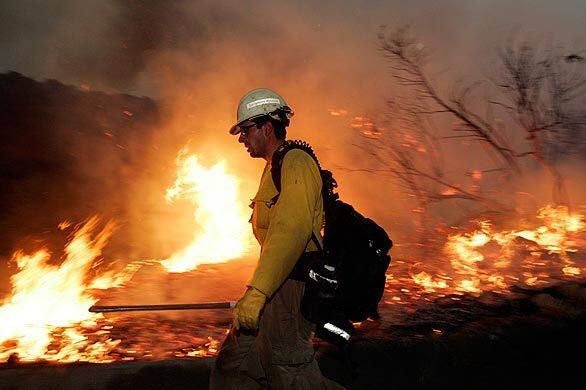
A firefighter walks along a control burn applied in the neighborhood of
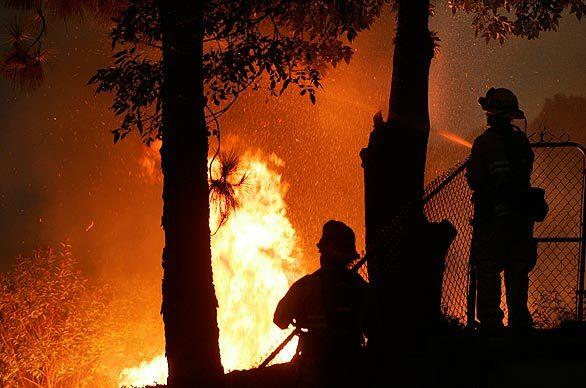
Capt. Scott Herring, left, keeps an eye on the flames as firefighter Jason Watkins keeps the trees wet in the backyard of a home in the 3000 block of Hopeton Road in La Crescenta. (Irfan Khan / Los Angeles Times)
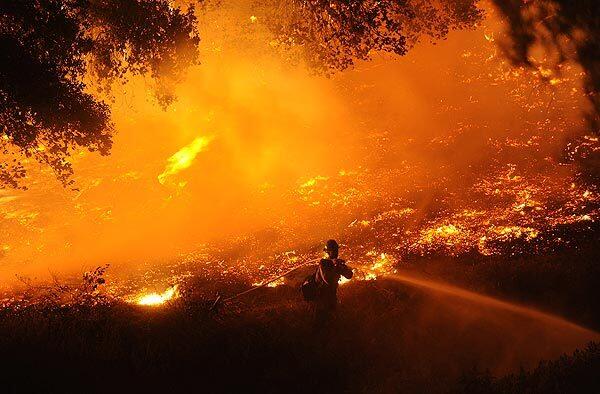
A U.S. Forest Service firefighter battles flames in La Crescenta. (Wally Skalij / Los Angeles Times)
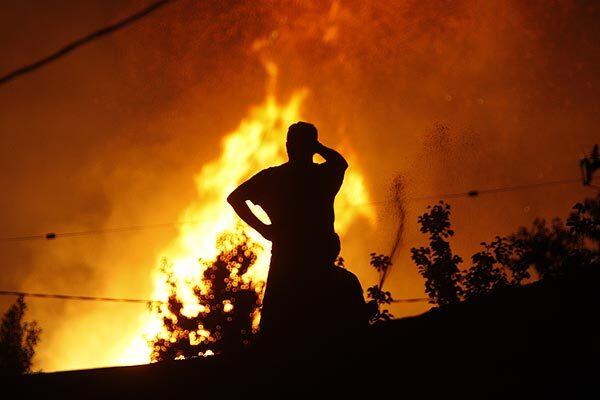
Robert Steffensen, 49, has lived in his La Crescenta house since 1975. He stands on his roof with a garden hose, trying to protect his home from falling ash. The Forest Service set a backfire to help protect the homes on this ridge from the sprawling Station fire. (Francine Orr / Los Angeles Times)
Advertisement
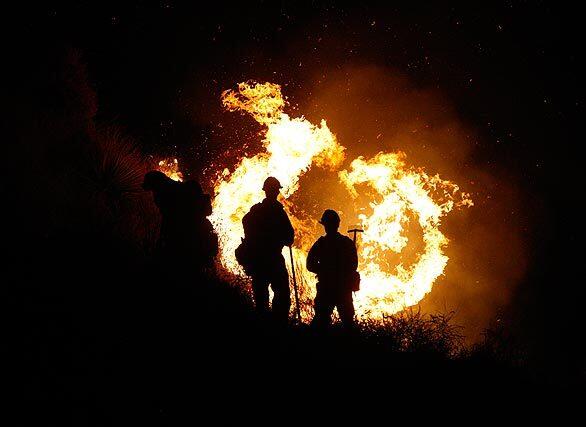
Firefighters on a backfire behind a home on Pinelawn Drive in La Crescenta. (Francine Orr / Los Angeles Times / August 31, 2009)
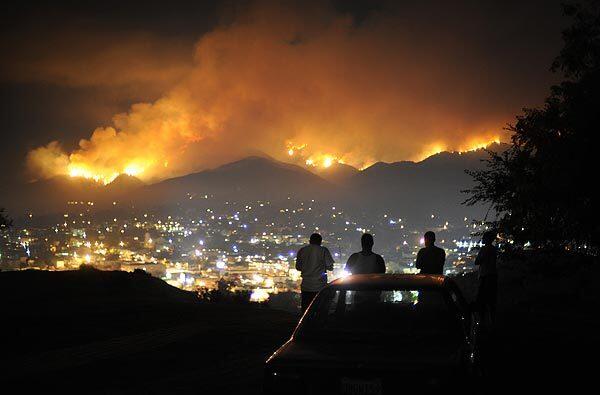
A group of young men watch the Station fire from a hill overlooking Tujunga on Monday night. (Wally Skalij / Los Angeles Times)
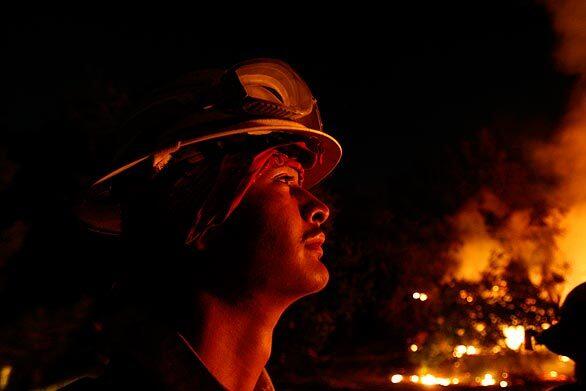
Matthew Cleaver, 20, of Arizona keeps an eye on a backfire near the corner of Rosemont Avenue and Rockdell Street in La Cresenta. The Forest Service set the backfire to help protect homes on the ridge. (Francine Orr / Los Angeles Times)
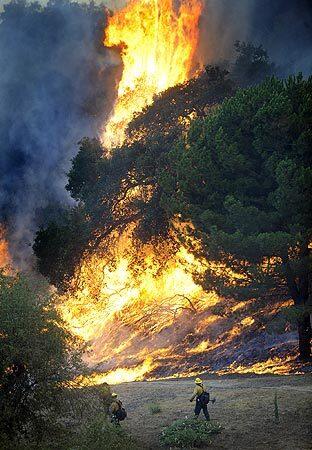
U.S. Forest Service firefighters watch closely after lighting a backfire in La Crescenta. The Station fire has burned more than 105,000 acres. (Wally Skalij / Los Angeles Times)
Advertisement
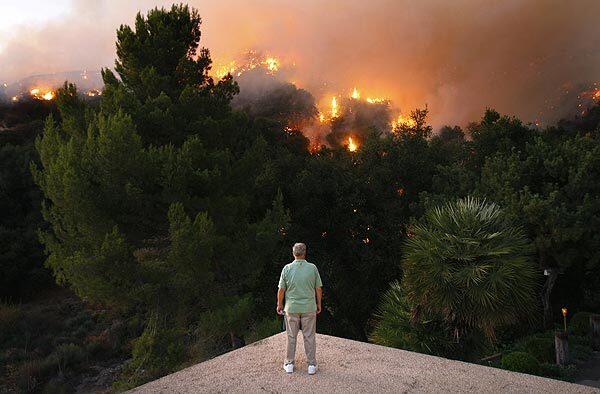
Roger Daniels, a La Crescenta resident since 1964, watches a backfire from the edge of his roof. (Wally Skalij / Los Angeles Times)
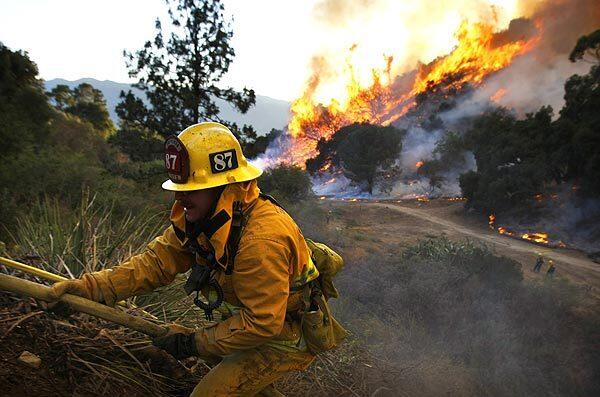
A firefighter climbs up a hose after a backfire is lit in La Crescenta. (Wally Skalij / Los Angeles Times)
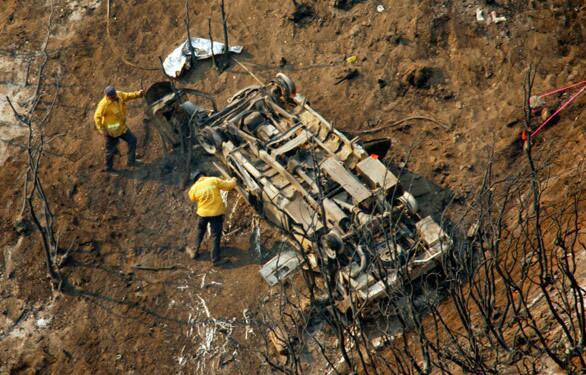
L.A. County fire investigators survey the vehicle that went off the road and fell nearly 1,000 feet down a steep ravine near Mt. Gleason in Angeles National Forest, killing county firefighters Tedmund Hall, 47, and Arnaldo Quinones, 34. (Al Seib / Los Angeles Times)
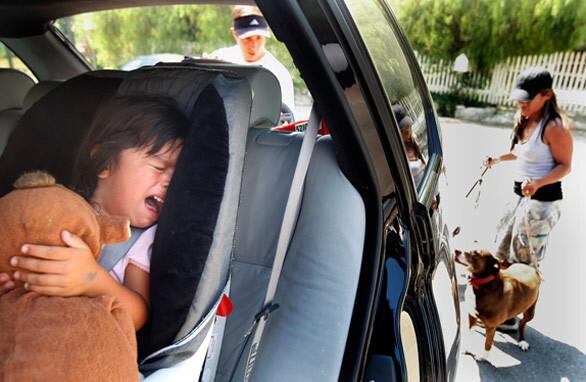
A scared Alexis Faieta cries in the back seat of the family vehicle as her parents, April and John Faieta, prepare to evacuate from Haines Canyon Avenue in Tujunga on Monday. (Wally Skalij / Los Angeles Times)
Advertisement
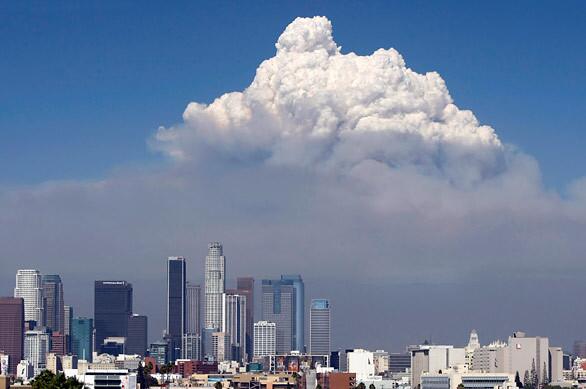
A towering pyrocumulus cloud created by the Station fire in Angeles National Forest billows into a blue sky behind downtown Los Angeles. (Don Bartletti / Los Angeles Times)
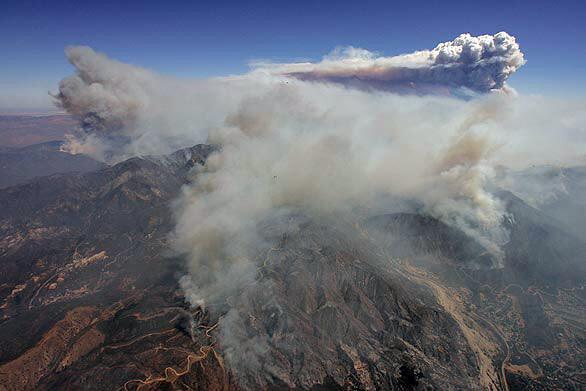
Smoke from the Station fire over the Angeles National Forest as seen from a helicopter. (Mel Melcon / Los Angeles Times)
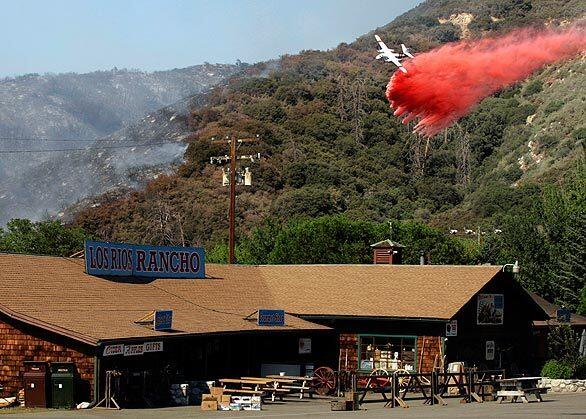
An air tanker makes a fire retardant drop behind Los Rios Rancho along
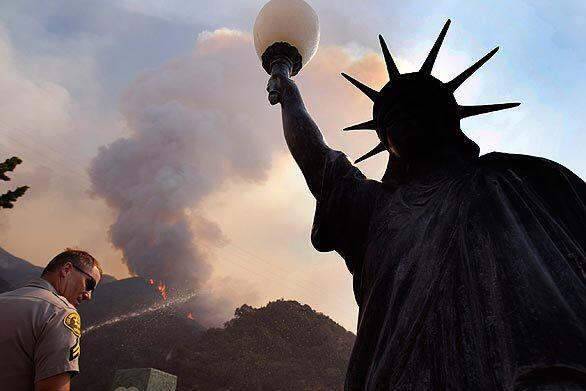
A
Advertisement
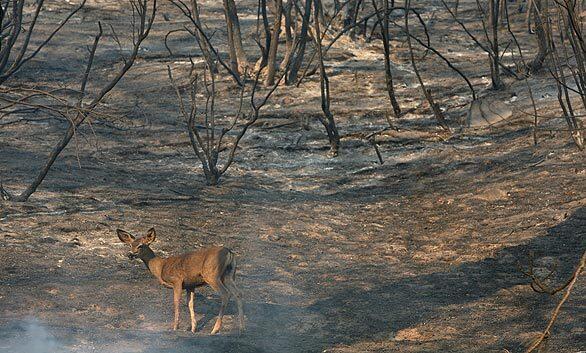
A deer walks through charred forest in the Angeles National Forest near Acton. (Justin Sullivan / Getty Images)
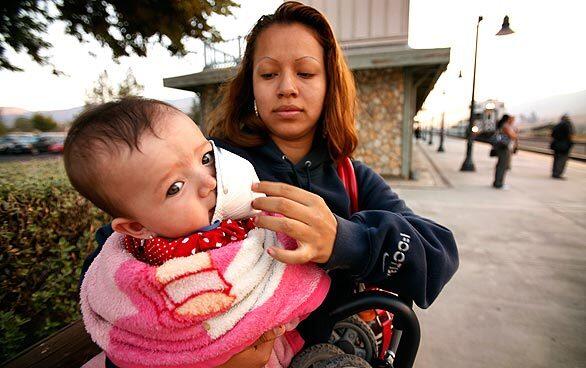
Jennifer DeLeon of Littlerock works to keep a mask on the face of her 8-month-old daughter, Emily Magana, as they prepare to board the 206 Metrolink Train at the Vincent Grade-Acton Station early Monday morning for a doctor’s appointment in downtown Los Angeles. The mask was provided by a Metrolink supervisor. (Al Seib / Los Angeles Times)
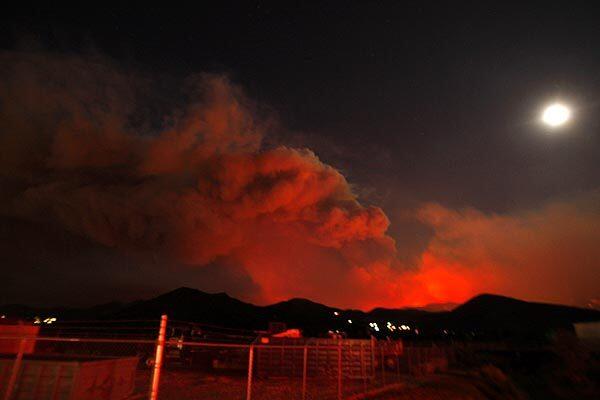
Smoke from the Station fire billows as the moon glows over Soledad Canyon Road in Acton. (Genaro Molina / Los Angeles Times)
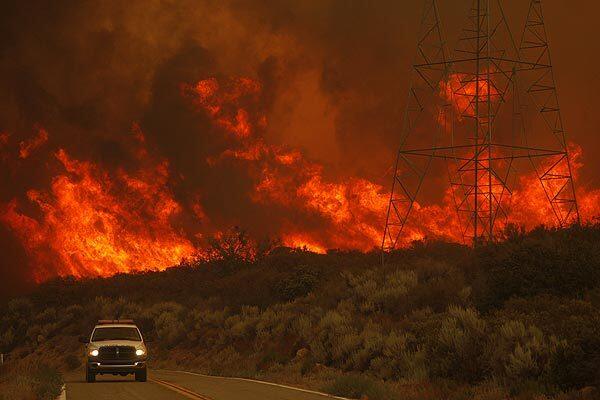
A firefighter retreats on Aliso Canyon Road in Acton as the Station fire rages (Genaro Molina / Los Angeles Times)
Advertisement
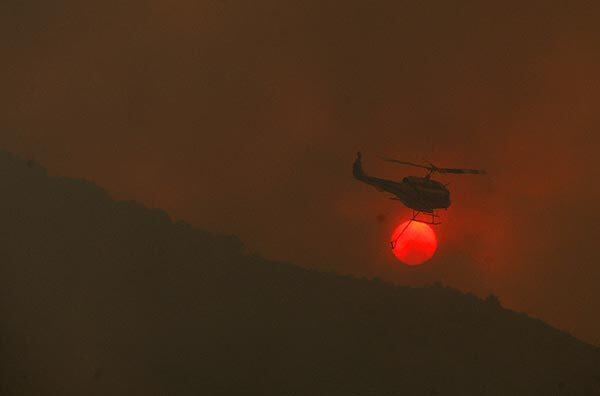
A helicopter finishes a water drop and flies over the setting sun over the town of Acton. (Genaro Molina / Los Angeles Times)
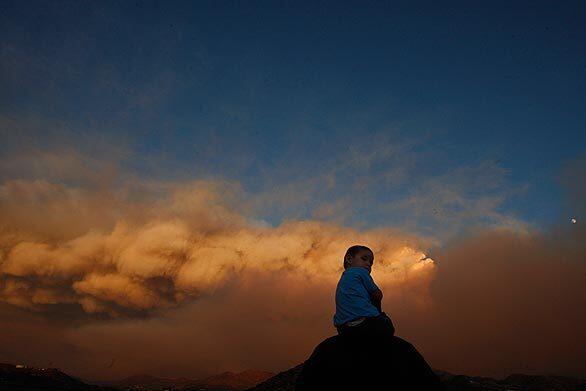
Will Moriarty and his son Max, 2, from Newhall, keep an eye on the Station fire along Soledad Canyon Road in Acton on Sunday. (Genaro Molina / Los Angeles Times)
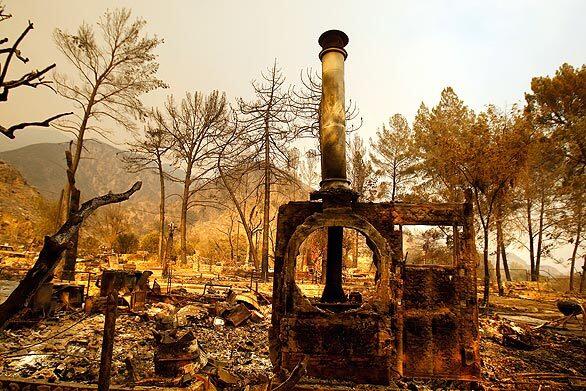
A chimney is all that remains of one of several structures that burned along Big Tujunga Canyon Road as part of the Station fire that has consumed thousands of acres and continues to burn. (Rick Loomis / Los Angeles Times)
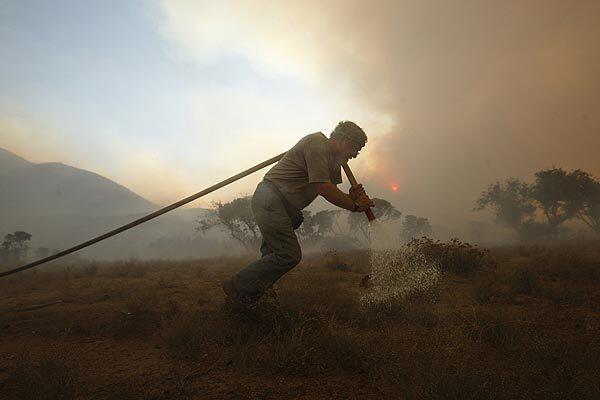
Ted Hamm stays behind to protect his mobile trailer home as the Station fire makes a pass to his property off Aliso Canyon Road in Acton. His home survived the flames. He’s been living on the property for three years and hopes to build on it. “We bought it for the view. It’s just not going to be as pretty,” he said. (Genaro Molina / Los Angeles Times)
Advertisement
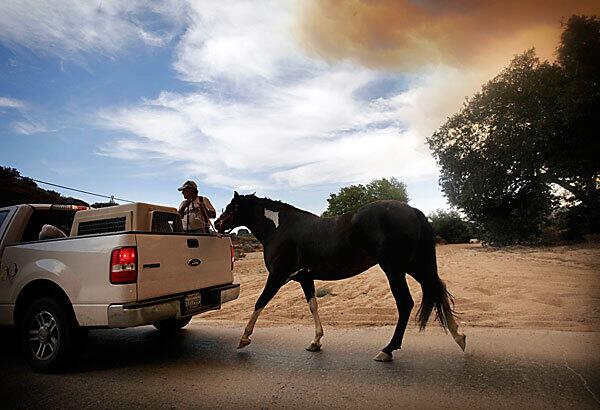
Under mandatory evacuation orders, residents began moving their animals and fleeing their homes as the Station fire approached the rural town of Acton on Sunday. (Barbara Davidson / Los Angeles Times)
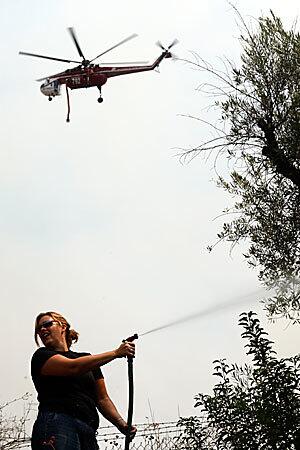
A firefighting helicopter prepares to make a water drop while residents on the ground try to put water on their roofs and surrounding brush in the area of La Ca?ada. (Rick Loomis / Los Angeles Times)



